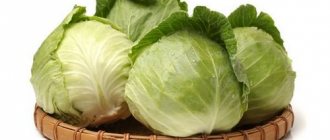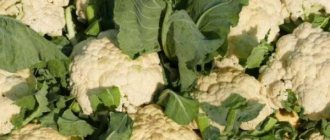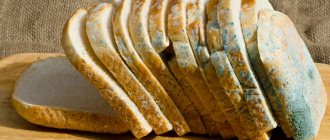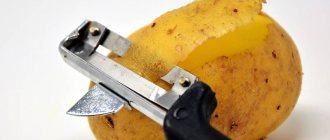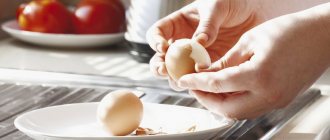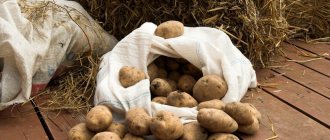Selection of raw materials for storage
To successfully preserve horseradish for the winter, you must initially give preference to the desired roots, which must be of normal hardness, free from rot, deformation, damage, and not be crooked.
The color of horseradish should range from light brown to yellowish. The cut should show a white or milky core. The timing of maturation is significant. A good mature root crop has a lifespan of three years.
The most selected varieties are as follows:
- “Valkovsky” - he will sing late.
- "Atlanta" - medium ripeness.
How to choose?
As a rule, horseradish is dug up in mid-autumn or a little earlier. But even if you do not have your own summer cottage, at this time you can choose suitable vegetables at the market. For harvesting for the winter, it is better to use large roots without unnecessary cuts. Thin roots or chopped pieces should not be thrown away - they will also come in handy. For example, to create seasoning. True, it retains its taste for only a few weeks, so it makes no sense to make preparations in large quantities for future use.
We recommend: How to store empty cans in an apartment: practical tips, signs about empty cans
Preparation for storage
In order for horseradish to remain fresh for a long time, it must be prepared correctly. Usually the root is dug up for storage in spring or autumn, it all depends on the variety. Harvesting is recommended in dry weather. Carefully dig up the plant with a shovel, shake off excess soil well and cut off the leafy part. Inspect the root crop for damage and select spoiled or rotten specimens: they are not suitable for fresh storage. You should not wash the roots after digging; it is better to leave them to dry in a warm, ventilated place for a day. After this, you can send the roots to a permanent storage location.
To make horseradish last longer, treat the cuts with iodine solution.
There are different methods for storing horseradish fresh or in seasonings. Typically, root vegetables are stored in the refrigerator, cellar or freezer. Roots can be preserved both in their original and processed form: dried, pickled, canned with other vegetables . Next, we will look at the most popular methods for storing root vegetables at home.
"Ogonyok"
The classic seasoning, which goes by many names, the most common of which are “Russian Adjika” and “Ogonyok”, is prepared on the basis of garlic and tomatoes.
Do you use expired food for cooking at home?
Yes, the main thing is to process it if it is meat or expired kefir for pancakes.
27.16%
No, it is very dangerous and not useful.
37.49%
If the products have fungus or mold, then we throw them away; if they are a couple of days past their expiration date, we use them for food, even without heat or other treatment.
35.35%
Voted: 1635
To prepare the sauce, the following products are required:
| Ingredient | Quantity |
| Horseradish | 100 g |
| Garlic | 100 g |
| Tomatoes | 1 kg |
| Sugar, salt | ½ tbsp. spoons |
| Vinegar | 1 ½ tbsp. spoons |
| Vegetable oil | 1/3 tbsp. spoons |
You can prepare the seasoning according to the following recipe:
- Grind horseradish and garlic in a meat grinder.
- Finely chop the tomatoes or grind them in a meat grinder.
- Add sugar and salt to the ground tomatoes, bring the mixture to a boil and simmer over low heat.
- 15 minutes after the tomato mass boils, add horseradish, garlic, vinegar, and vegetable oil.
- Cook the mixture over low heat for 10 minutes.
- Pour the sauce into sterilized jars.
- After cooling, put the seasoning in the refrigerator.
The shelf life of “Russian Adjika” can reach 10-12 months.
Temperature and storage conditions
In warm conditions, the vegetable germinates and loses its hardness in about 30 days. Therefore, storing rhizomes requires low temperature and high humidity. Such conditions will ensure its juiciness and nutritional value.
Options for storing raw horseradish for the whole winter at home: place in the refrigerator, freeze, put in a box in a cool place. Optimal storage temperature: from 0 to 5 degrees, humidity: 80-90%. Shelf life 1 year.
Too cold a temperature will freeze the fresh vegetable and make it unfit for consumption. Check the settings carefully.
How to use frozen horseradish
It is important not only to freeze the product, but also to use it. Then you won’t have to empty the freezer in the spring and throw away the food. Let's talk about the main methods of using horseradish. Let's share some tricks.
In cooking
Frozen leaves are used for marinades, less often soups, sauces. Much more interesting are the ways to use the roots. It is impossible to imagine Russian cuisine without them. Grated horseradish was served with lard, jellied meat, and used for various dishes.
Application options:
- cold sauces. Mix with garlic, sour cream, sometimes boiled beets, various herbs;
- soups. Add to okroshka, beetroot soup, add to borscht, pickles, kharcho when serving;
- snacks. Horseradish is used to complement a meat plate, sliced lard, and sausage. It is served in a separate gravy boat for spreading on bread;
- adding to salads. It goes especially well with meat ingredients, pickled mushrooms, cucumbers, and boiled beets. A vinaigrette with grated horseradish turns out to be interesting.
Thawed horseradish becomes less spicy, low temperatures make the taste more tender, and the pieces soften. You can add more than the recipe calls for.
In folk medicine
Horseradish is used as a general strengthening product. For maximum preservation of nutrients, we recommend freezing at the lowest temperatures. Do not remove from the freezer in advance.
How to use:
- just for food. See culinary options above;
- mixtures. Combine with garlic. Sometimes the ingredients are topped with honey and vegetable oil. Used daily;
- juice of rhizomes, leaves. It can also be frozen. Drink a teaspoon to restore blood and cleanse the liver;
- with milk. Add 1 tsp to a glass of warm drink. grated root. Drink for coughs, sore throats, and other colds.
It is believed that the juice prevents the formation and growth of tumors. You can freeze it in ice cube trays. The only problem is the roots; the leaves are quite hard and contain little moisture. You will need to grind and squeeze out a considerable amount.
Methods for storing horseradish
In the cellar
It is most practical to store horseradish in the cellar. Place the roots in sawdust/sand to prevent them from wilting. As a rule, you can store horseradish roots at home until mid-summer; the vegetable retains its freshness and vitamins.
Properly prepare the cellar in advance where the roots will be stored in the winter. Whitewash the walls and ceiling, remove any rotten vegetables and do a thorough cleaning. A proven method is smoke treatment, but the room requires curing for about two weeks before adding vegetables.
When the cellar is prepared, you can start planting root crops:
- Prepare the required number of boxes.
- Cover the bottom of the boxes with sand or sawdust, lay layers on the surface so that the roots do not touch.
- Repeat the steps, laying out sand/sawdust and rhizomes in layers alternately.
To avoid product spoilage, check your vegetables once a month. If necessary, remove damaged, diseased roots.
When the roots dry out, it is necessary to place wet sand in the box, otherwise the vegetable will become flabby.
If the quantity of root vegetables being harvested is small, tie the dried roots into bunches and hang them from the ceiling to save space in the cellar. You can cover it with ash to prevent the vegetable from sprouting.
Horseradish is perfect for long-term preservation, as it has natural bactericidal properties.
How to keep vegetables fresh in an apartment
How to store horseradish at home if you don’t have a cellar:
- If there is a balcony, the technology of laying in sand is used on the balcony.
- To prevent severe frost from spoiling the harvest, cover the container with roots with a blanket or felt.
Refrigerator and freezer
In your apartment you can store horseradish in the refrigerator . For this method, choose roots no longer than 25 cm. Clean the root vegetables from the soil and pack them in cling film, leaving several small holes for ventilation. In this form, horseradish can be stored for about 3 weeks if you keep it on the vegetable shelf.
To extend shelf life, use the freezer . The composition of the root crop allows it to easily withstand negative temperatures without losing its qualities for 6 months . Peel the roots and cut into small cubes, then pat the workpiece with a towel to remove excess moisture. Chopped horseradish can be packaged in containers in portions or stored in the freezer in one bag.
It is convenient to store in the refrigerator not only the root, but also horseradish leaves , which are in particular demand during the preservation season. Wrap the dried herbs in a bag or cling film and place in the coldest place. In this form, the horseradish leaf will last for 2-3 weeks.
Drying
Drying is a popular method of storing champignons, which is also suitable for horseradish root, allowing you to save it for the winter at home. When used, vitamins and taste are preserved. Crushed dried roots are actively used in cooking - added to soups, spices and sauces are made.
Before drying, you need to prepare the roots: clean them from soil, cut off shoots and tops.
After this, wash the roots thoroughly with water, dry well with a dry towel (you can peel them off), and leave to air dry.
Immediately before drying:
- scroll through a meat grinder;
- cut into thin strips/circles;
- just cut lengthwise.
How to store horseradish for the winter in the refrigerator. Making a spicy horseradish seasoning
How to store horseradish in the refrigerator as a seasoning? It's quite simple. After digging up the horseradish, you need to wash and clean it. Next, chop the root vegetables. We do this using a coarse grater or meat grinder. Then you should wash the jar in which the seasoning will be stored and sterilize it. Place the chopped vegetable in a glass container. Sprinkle sugar and salt on top to your taste.
We recommend adding lemon juice or preparing horseradish with beets. Place the prepared seasoning in a jar, close the lid and put it in the refrigerator. If you plan to store the seasoning for a long time, add a little vinegar to it. It will help maintain the bright taste.
Many housewives use horseradish storage in the freezer and refrigerator. But besides this method, there are others that are no less effective. Many vegetables and homemade preparations can be easily preserved by simply sending them to the cellar or underground. There are all the conditions necessary for the preservation of food: air temperature, humidity and darkness. To store the spicy root vegetable in this way, you need to place it in a wooden box, which we also fill with sand.
How to properly store fresh horseradish?
For better wintering of horseradish roots, retention of valuable substances and properties in them, you should adhere to these recommendations, they will allow them to remain fresh throughout the winter period:
- Wooden boxes containing sand work well. Root vegetables are well cleaned of sand and soil and placed in containers in one row to avoid contact of the fruits with each other. Sprinkle everything with sand on top so that there is a layer of 1-2 centimeters.
- The sand should always be saturated with moisture, so it must be periodically sprayed with water.
- Polyethylene bags will also help preserve the horseradish. Before harvesting, the roots are washed and left to dry so that they are completely dry. The fruits are placed in bags and filled with air, thus creating a seal. They can keep for four or five months in this package.
- You can achieve freshness by using peat litter. First they are laid out, then sprinkled with peat so that the layer is very thin. Thanks to the antiseptic effect of peat, the roots can avoid rotting.
- Temperature mode while maintaining no less than 0 and no more than plus two or three degrees. Humidity levels should be 80-90%.
- The safety of horseradish roots can only be ensured in a room where there is good ventilation.
Is it possible to freeze horseradish in the freezer with whole roots to preserve the vitamins?
In winter, the roots can be stored frozen. At the same time, it does not lose its sharpness, healing properties and does not run out of steam. To do this, it is important to know some nuances.
To begin, the roots need to be soaked in cold water for 2-3 hours. Then we clear them of the top layer and immediately place them in a basin of water so that it does not fizzle out and does not irritate the eyes so much.
Make sure to dry the horseradish. Place the product tightly in bags or plastic containers. Place in the freezer. In this form it can be stored for one year.
How to store horseradish roots
Horseradish roots can be stored fresh, dried, frozen, or as a ready-made seasoning.
- If you have a glazed balcony, fresh vegetables can be stored there by placing the roots in sand or on a peat bed to avoid rotting.
- Keep the dried seasoning in a dark, cool place away from moisture.
- Place the frozen chopped rhizomes into a bag and store in the usual freezing mode until use.
- Grated and ground horseradish is stored compactly in the refrigerator/cupboard in a small jar, the most convenient way.
To ease friction, the roots should be soaked in cold water for 1 hour. Horseradish contains volatile substances that can irritate the eyes; to prevent irritation, place a thick bag around the opening of the meat grinder. A food processor will help you twist and grind.
Pack the resulting mass into bags/small containers and put them in the freezer. The vegetable will retain all its beneficial substances and can be stored for up to a year.
To obtain ground horseradish, you need to wash the root crop, peel off the skin, chop finely and dry it in the oven. After drying, the product is placed in a coffee grinder and ground into powder.
Store the powder in a cool, dry place in a glass container.
Ground horseradish is added to various sauces (for example, tomato) for piquancy and spice.
In addition to being used as a savory seasoning, ground horseradish is suitable for canning and preventing mold and mildew in canned vegetables. Just add 1 tbsp. l. hot seasoning in the brine of cucumbers, tomatoes, and other canned products when preparing - the jar will not become cloudy or moldy. Can even be used on open cans.
Preparing roots for storage
Being a perennial crop, horseradish accumulates a lot of juice and nutrients in the roots by the end of the 2nd growing season. By the 3rd year, they already have more dry matter and less juice, and in the future this disproportion only increases - the root becomes very hard, “basted.”
Tip: The roots of a two-year-old plant are best suited for storing horseradish at home. You can also harvest three-year-old ones, but they will initially be less juicy and aromatic.
There are only 2 ways to store horseradish roots: in the roots or chopped. Usually, when stored in roots, some of them are inevitably discarded, and experienced housewives put them into processing, simultaneously using both methods.
To store the roots, you need to dig them up in late October - early November. You can extend this period until mid-November, but only if there have been no frosts - after that the roots become brittle and will not be stored for a long time.
Dry the dug roots slightly, clean them of soil and remaining tops and sort them thoroughly. Ruthlessly discard roots with large cracks or spots of rot, but do not throw them away - they will be recycled. You should not wash the roots from the ground: if they absorb moisture, they will not be stored for long.
We prepare horseradish for the winter. Recipes for delicious horseradish for the winter
It is impossible to overestimate the role of horseradish in home canning. Rhizomes and dried leaves give pickled products a special pungent taste and piquancy. Experienced housewives prefer not only to add seasoning to jars of vegetables, but also to prepare it themselves for the winter. Seasonings and sauces with horseradish will not only complement meat and fish dishes, but will also help strengthen the immune system, which is especially important during the winter cold. Since there are practically no useful substances in purchased jars of the product, preparing fresh product at home is especially relevant.
Beneficial features
Horseradish occupies a leading place among traditional medicines. Using seasoning preparations will help support the body during the difficult winter period.
The beneficial properties of horseradish are varied.
- The product is used to prevent colds. Helps remove mucus from the body.
- Protects the body from infectious diseases due to the presence of phytoncides in the composition. Because of this property, horseradish is considered a natural antibiotic.
- The seasoning is recommended to be consumed in small quantities for diabetes mellitus because it helps normalize blood glucose levels.
- Horseradish improves appetite and stimulates gastric peristalsis. For this reason, it is served with fatty and heavy foods. It also improves the functioning of the gastrointestinal tract as a whole. Helps with constipation.
- Promotes the removal of bile from the body.
- Has a diuretic effect. Horseradish eliminates foci of inflammation in the urinary tract, treats cystitis and dropsy, and helps get rid of kidney stones. Doctors often recommend the seasoning as an addition to primary drug treatment.
- Has a beneficial effect on teeth, protects enamel from destruction.
- Eating horseradish can improve male potency.
Preparing horseradish for winter
If you want to preserve a fragrant vegetable in winter, it must be properly collected and prepared. Dig up the roots in late autumn after the end of the growing season. The best period for harvesting is October and early November; the ground should not be frozen. Cleaning is carried out in dry weather. You can stock up on horseradish leaves until frost.
Use a fork to dig to avoid damaging the plant. In dense soil you will have to use a shovel. It is recommended to remove rhizomes about 10-15 cm in size, otherwise their storage will be ineffective. Shake off the soil and cut off the tops. Roots that are supposed to be stored in the cellar are not washed, as this can lead to rotting. Large roots are slightly cleared of lumps of earth, dried for several hours, then planting begins.
Horseradish roots should be dug up only after the plant has already reached two years. During this period, they become thick and long enough for harvesting.
For storage and harvesting, choose exclusively healthy, clean roots without any traces of disease. Otherwise, all the prepared horseradish will spoil.
If you plan to use the seasoning for culinary purposes, choose roots that are two to three years old. They do not yet have increased fibrousness, the roots are tender and juicy.
To keep horseradish longer, you need to treat the cuts with iodine.
Using the cellar
Without a doubt, storing horseradish in the cellar is the most convenient way to prolong its freshness. In addition to simplicity and practicality, the advantages of this approach include the fact that horseradish easily tolerates proximity to other vegetables and root vegetables. This will allow you to save space and time by preparing several types of vegetables at the same time.
Successful storage involves several steps. It includes:
- harvesting and processing;
- cellar preparation;
- laying vegetables.
Preparing the premises
You can store horseradish both in the cellar and in the basement. Before planting the crop, it is important to make sure that suitable conditions are created in the selected room. To do this, carry out cleaning and careful inspection. If you find mold or pests, first remove them yourself or with the help of professional pest controllers. For basements, it is advisable to use smoke bombs, as they are guaranteed to solve all problems. Keep in mind that after using them, crops and preparations cannot be placed in the cellar for 2 weeks.
Horseradish roots have bactericidal properties, which allows them to be stored for a long time.
If you find out that the fungus appeared due to high humidity and insufficient ventilation, eliminate these shortcomings. Insulate the walls and floor, place heating devices in the cellar and ventilate it regularly. These simple measures will protect your crop from disease and rot.
Laying the harvest
After preparation is completed, you can start adding horseradish. For this you will need large wooden boxes. Fill their bottoms with soil and place the first layer of vegetables so that their roots do not touch each other. Then you can make a few more layers by sprinkling the roots with damp sand. It should not contain earth or other impurities.
If the horseradish was collected in the spring, it may germinate. To avoid this, sprinkle the roots with slaked lime. Place them in the box according to the described principle. Remember to check your supplies regularly. If vegetables begin to rot, immediately remove all spoiled ones and treat adjacent ones with special antifungal solutions. Also, do not allow vegetables to dry out excessively. If the roots become dry, add some damp sand to the storage box.
Due to its special composition and bactericidal properties, horseradish is suitable for long-term storage. Under suitable conditions and constant inspection, it can be stored for one and a half years.
If you don't have a cellar or the conditions in it are unsuitable, you can still stock and store vegetables in the winter. Use one of the following methods.
How to store leaves
The leafy mass of the plant is rich in carotene, vitamins, essential oils, and phytoncides. The leaves have long been used for preparing salads, marinades, and preserves.
You can prepare horseradish leaves for the winter by drying or freezing. Pre-wash and thoroughly dry the foliage. After grinding, process using the chosen method.
- Frozen foliage will last 9-12 months and is suitable for canning.
- The dried product is usually crushed and used for seasoning soups and marinades. The shelf life is up to six months, then the leaves turn pale and are thrown away.
- Fresh leaves in an airtight bag will keep on the vegetable rack for 2-3 weeks.
Do you know that…
The plant is used for early forcing to obtain vitamin-rich greens for making salads.
There are many different ways to prepare healthy roots. Choose the appropriate option, and the aromatic seasoning will strengthen your immunity, protect against diseases, and add an interesting flavor to your dishes.
Is it possible to freeze horseradish
Horseradish is usually salted or used in various marinades. The famous Russian sauce is prepared on its basis - horseradish, gorloder, horseradish, ogonek. Each region has its own name. The essence is the same - the result is a very aromatic, spicy tomato with a fresh taste. No vinegar or preservation. Aspirin is occasionally added. The pungent root itself is an antiseptic. It perfectly kills bacteria and prevents fermentation.
Housewives often ask whether horseradish can be frozen. In fact, this is one of the best ways to prepare roots and greens. The product retains its properties completely. At the same time, the aroma weakens slightly. It does not irritate mucous membranes.
You can freeze horseradish roots and leaves in the freezer.
Do you prepare horseradish leaves for the winter?
Not really
Is frozen horseradish healthy?
The root contains 11 vitamins. Among them there is especially a lot of choline. Microelements are present - aluminum, zinc, fluorine, chromium and more than a dozen more. There are macroelements - potassium, sodium, phosphorus, chlorine, sulfur, silicon. In addition, there is a huge amount of plant phytoncides, organic acids, and essential oils. If frozen correctly, horseradish will retain up to 99% of all these substances.
Useful properties of garden horseradish:
- increases immunity;
- kills viruses, bacteria, helps fight flu and colds;
- cures runny nose;
- speeds up metabolism;
- increases appetite;
- is a source of vitamins and minerals;
- relieves pain from rheumatism;
- returns masculine strength;
- improves liver function.
The product can be frozen in the freezer exclusively for medicinal purposes. But they are used internally, externally, used for the prevention and treatment of colds, strengthening the immune system, beauty and health. Another product that is recommended to be frozen for the winter is fresh fern.
Can horseradish do any harm?
A burning product will cause harm to health in case of any diseases of the digestive system. Horseradish contains irritants. Possible exacerbation of ulcers, gastritis, colitis. Another contraindication is liver disease. Do not use during pregnancy or breastfeeding. The presence of any inflammatory processes requires prior consultation with a doctor.
Horseradish is contraindicated in some cases for oral administration, but no one forbids inhaling its aroma. Inhalations will help cope with runny nose, colds, and coughs.
Storage after processing
There is not always a suitable room to keep horseradish fresh. In an ordinary apartment, you can make a stock from a recycled product.
Pickled horseradish
Canned horseradish can be stored for as long as possible – up to several years. For preservation, it is advisable to dig up the roots immediately before the procedure. The fruits can be soaked overnight in cold water - the raw materials will be easier to grind. Before pickling, the roots must be thoroughly washed and cleaned. The peel should not be cut off, but scraped off with a knife. The peeled pulp should be grated on a fine grater or ground in a meat grinder.
For 1 kg of crushed raw materials you will need:
- 250 ml water;
- 1 tbsp. spoon of salt;
- 1 tbsp. spoon of sugar;
- 125 ml apple cider vinegar (6%) or 1 tbsp. spoon of citric acid.
Boil water, dissolve salt and sugar in it. After removing from heat, add vinegar or citric acid. Pour the solution into a container with grated horseradish and mix well. Fill a sterilized jar up to the neck with the mixture. It is important that there is minimal space left for air in the jar. Immediately after this, the jar is covered with a lid and rolled up.
Attention!
When grinding fresh raw materials, it is necessary to protect the respiratory system with a medical mask and the eyes with goggles. You can put a plastic bag on the meat grinder into which the finished mass will fall. Volatile substances released when grinding root vegetables can damage mucous membranes.
Freezing
At subzero temperatures, the nutritional qualities of horseradish remain unchanged for 5-6 months. The defrosted product does not lose its taste, aroma and juiciness. In addition, the method allows you to preserve damaged raw materials; it is enough to trim off the affected areas, preserving the surviving pulp.
Before freezing, the root vegetable must be washed and peeled, then cut into 3-5 cm cubes or grated. Blot the raw materials with a paper towel to remove excess moisture, pack in a plastic bag and place in the freezer.
Before use, it is recommended to grate the cubes before they thaw. In this case, horseradish will not release substances hazardous to the eyes and nose.
Drying
The blank can be used for 1-2 years. Dried horseradish roots retain a pleasant aroma, but partially lose their taste.
You can dry horseradish naturally, but the process will take a long time, so you should use the oven. After peeling the root vegetable and cutting it (in halves, slices, or grated), you should place the raw material on a baking sheet in one layer. You need to place it in an oven already heated to +60°C and keep it at this temperature for about 40-60 minutes. After cooling, the horseradish slices can be crushed for ease of use - grate, pound in a mortar, grind in a coffee grinder.
Dried horseradish should be kept in containers made of natural materials, for example, in a linen bag. It is better to store the powder in a glass or ceramic container with a tight lid so that the aroma does not evaporate.
The preparation is well suited as a seasoning for first courses and making sauces. Before use, the product must be soaked in water for an hour.
Pounded horseradish
You can also save horseradish in the form of a ready-made seasoning. In the refrigerator, horseradish sauce is edible for 2 months, although it will be most delicious in the first 2-3 weeks.
The washed and peeled horseradish root should be minced in a meat grinder along with garlic, mixed with chopped tomato pulp and salt, sugar and spices added to the mixture. One part of horseradish requires 10 parts of tomatoes. The volumes of horseradish and garlic should be equal, but to increase the shelf life of the dish, the proportion of garlic can be increased. On average, for 2.5 kg of the finished mixture you need 2 teaspoons of salt and 1 teaspoon of sugar.
The mixture should be placed in a sterilized jar; for longer storage, you can roll up the jar of sauce as a preserve.
Advice!
The sauce can also be placed in small plastic containers or plastic bags and frozen. The taste and benefits of the seasoning are perfectly preserved after defrosting.
How to preserve horseradish passed through a meat grinder. Horseradish with vinegar - classic recipe
- Ingredients - 400-600 grams of horseradish roots.
- Marinade (brine) - 400-600 ml water, 40-60 ml (3-4 tablespoons) 9% table vinegar or 60-90 ml 6% (5-6 tablespoons), 20-30 grams of salt (2 -3 heaped teaspoons), 20-30 grams of sugar (3-4 heaped teaspoons).
By the way!
You can take 6% apple cider vinegar or wine vinegar. And to keep the grated horseradish sharper, you can reduce the amount of added sugar or not add it at all.
The sequence of steps for preparing horseradish with vinegar for the winter:
- Wash the horseradish roots and peel them (it’s convenient to use a regular vegetable peeler).
Advice! If the horseradish roots have dried out, it is recommended to put them, unpeeled, in cold water for 30-60 minutes.
- Prepare the marinade: dissolve sugar and salt in water, add vinegar + other ingredients and mix.
Advice! Heat treatment (using boiling water) reduces the amount of nutrients in vegetables, so it is recommended to use boiled water cooled to room temperature.
- Sterilize horseradish jars (boil together with lids).
Think! It is believed that horseradish cannot ferment, which means there is no point in sterilizing jars.
- Grate the horseradish roots on a fine grater, pass through a meat grinder or grind in a mixer.
Important! When passing horseradish through a meat grinder, be sure to immediately put a plastic bag on it so that the “horseradish fumes” do not hurt your eyes. And in general, you shouldn’t joke with horseradish - it burns your eyes worse than onions.
- Pour the marinade into the chopped horseradish and mix thoroughly until smooth (in a separate container).
- Fill the sterilized jars with horseradish and close the lids.
If you wish, you can pasteurize the finished product in jars for 15-20 minutes and only then screw on the lids.

